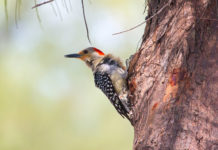Back in 2012, I wrote my first story for the Keys Weekly that put me on the map, so to speak. Never mind that I had already written tons of informative articles about complicated planning matters, the environment, education, etc. My “big story” was about … bugs. Yep, the millipedes. Suddenly friends and strangers, who never once mentioned reading any of my articles, were stopping me at the grocery store to talk about the yellow-banded “crunchy worms” that had shown up all over the Middle Keys.
I have too many good things to say about the Keys Weekly Newspaper and Marathon community to put into words here, my last issue as editor. (Though I plan to be a frequent contributor for the rest of my life.) I know that I am leaving at the top of my game for the top news organization in the Florida Keys and I am proud of what we have all achieved together. I know that the friendships I have made at the paper, and through the paper, are forever.
Mark and I will never leave Marathon — we love it way too much — but look forward to being able to get off the rock to see our family more often. Who knows, we might even begin to socialize at places other than the shop or the office.
You know who else didn’t leave? The bugs. And so I’ll back slowly and quietly into the bushes a la Homer Simpson with this, the story that put me on the map, published in the Oct. 13, 2012 issue of the Marathon Weekly.
They’re millipedes, dang it!
Household mystery bugs explained
By Sara Matthis
Those little yellow and black-striped crunchy worms that seem to appear magically overnight INSIDE Keys homes have a scientific name. Officially, they are called the yellow-banded millipede.
And we got ’em first.
“The record states that they were found first in Monroe County in 2001,” said Kim Gabel, her very professional tone suggesting otherwise. Gabel, a horticulture agent with the University of Florida’s Monroe County Extension Service, said it’s not known how the Caribbean bug landed on our shores, but it has since spread to Broward and Miami-Dade counties.
Gabel assures callers (me) that they are just a nuisance. They aren’t venomous or destructive. They don’t eat household plants or poison pets. They just make a really disconcerting crunching noise when stepped on — barefoot — in the middle of the night. Oh, and if you don’t turn on the light and clean it up right away, it’s gonna leave a mark.
“I just sweep them up and put them back outside,” Gabel said. “They are part of nature’s brigade, so to speak. The bugs break down our wood chips and create a nice fertilizer for us.”
For those seeking a more permanent solution, try adding some weather stripping to the front and back doors. Seal up the vents to the outside. It’s possible the bugs are seeking the light or moisture. Certainly, if the millipedes knew what they had coming to them, they wouldn’t want inside the house.
“Once they enter the building, usually within 24 hours, they die due to the dry conditions,” reads one pamphlet.
One last note: Monkeys in a Miami-Dade County zoo have been observed rubbing their fur with the yellow-banded millipedes. Some grackles (songbirds) have been seen to do the same thing. Apparently, millipede secretions act as an insect repellent. Eeeewww.


























